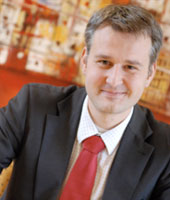By: Campbell Lockhart / Rick Wielens
We are on the executive floor of the imaginary pharmaceutical company PharmaX, it is Q3 and the top management is preparing for the annual innovation review. The year has been tough with revenue being hit by generic competition as their major products come off patent, but then it has been difficult for all the industry. This is the first article in a series of three. Parts 2 & 3 will be published in the next 2 weeks.
Gordon, recently appointed CEO and president, is reshuffling the papers and reports that he has spent the afternoon studying and will use in the meeting tomorrow. With the recent unexpected resignation of the CEO who had been there for over 10 years, he has been brought in at the beginning of the year to reshape the business and his experience in the automotive industry was seen as a way of bringing a fresh vision and a lot is expected of him.
He joined the company knowing that PharmaX is built on a strong reputation in innovation and that he has inherited a team of seasoned professionals. But in the papers that he has been going over is a report from one of the big 3 that he commissioned and what he has seen does not paint a particularly bright future, particularly on the innovation front. He knows that the meeting tomorrow is going to be a key moment in understanding this business and he is going to have to take important decisions for the future, some of these might be hard to take.
Across the corridor, Jim VP of R&D, is finalizing his presentation. He has spent hours with his team reviewing the portfolio, analyzing the different scenarios and making sure that his Powerpoints are clear and meaningful. He has taken into account that Gordon is not an industry veteran and that the form of this presentation is going to be key in passing his message. He flicks through the slides for a final check (he thinks “over 70 which is way too many”) but feels that he has nailed the main points and is confident that it is full of potential success, but these will not have impact before 5 years.
Jim knows that Gordon has commissioned a consultancy report but is troubled as he has not had access to the conclusions or recommendations and slight doubt creeps into the back of his mind. He turns again to check his presentation, realizing that he is starting to over-tweak it.
Meanwhile, next door Francis, VP of finance, is printing off copies of his financial report that show the use of resources and how these have been deployed in the R&D effort and a forecast of the results. He has climbed the career ladder there and has experienced the exceptional growth of PharmaX and how this has been built on the successful development of blockbuster drugs, he is a firm believer that growth lies in innovation. But recently the financial market has been punishing PharmaX and the PER is under pressure. Francis shrugs this off, thinking that it is just a temporary passage and that PharmaX is experiencing this down-turn because of general industry trends. He has confidence in Jim.
The next day, when Gordon enters the board room he is a little late, all heads turn expectantly towards him. But rather than launching into an introductory pep talk he invites Jim to go directly into his presentation. Jim feels flattered and takes this as a mark of confidence. Gordon has already taken a quick look at it and this is what has made him late as he received it only that morning. Jim takes the best part of the morning to go through all the details. He is aware of the time he is taking and that Gordon is not reacting to anything, just taking lots of notes, and he is concerned that he has lost the attention because of the length of the presentation. He uses all his enthusiasm to punch home the depth and breadth of the various options in the portfolio and how he proposes to fit these into the strategic corporate domains, the potential indications and territories that could be conquered, how these can be developed with partnering, with companion diagnostics, patient targeting…… what he thinks are all the right stuff for the future of PharmaX.
But Jim knows that all these options are coming from outside the company and he has a significant number of participations and collaborations to manage. He tries to underplay this, making his team shine by their performance. Jim’s final word is that the pipeline is strong with potential to consolidate and defend their market position… but results will not be visible before 5 years. He adds a cautionary note that the risk of clinical failure is high. He sits down pretty pleased with the way it went, turns towards Gordon.
There is a silence as Gordon continues to note before turning to the meeting, “how many of these projects are going to give us blockbuster status products? Seems that there are not many and our immediate IP position is not so strong”
Before Jim can answer, Jean VP of regulatory affairs, chips in a little sharply, “Everyone knows that that era is over, it is better to focus in on rare diseases, targeted patient cohorts and orphan drugs, it’s the only sure way in the future. That way we can set high prices on smaller market share.” Francis cuts in, “Gordon, it is extremely important to understand the dynamics of this, it’s getting harder in the traditional areas as the payers are reluctant to accept to cover our R&D expenses into pricing, particularly if the patient benefit is not high.”
Gordon turns towards Francis, “R&D costs, are we not spending too much? It looks like we are leaving a lot outside the company… an maybe spreading it too thinly.”
Francis, “They are in the industry norm, 15%, any lower and we would not be competitive.”
Gordon, “ I’m sure you are right, but the value….. in dollars, how much we are actually spending……. And how this is being deployed”
Francis is puzzled as he has already provided this, “ you have the figures, 5.5 billion per year…….. we employ over 3000 researchers in that and approximately 25% is used for external collaboration, you can see that in the discovery program, all out-sourced…. All pharma have this strategy, it’s the way of mitigating risk.”
Gordon, “This is a lot of cash……Does anyone here have any idea of the contribution that new products, say from the last 5 years, make to our annual revenue ?…. Jim, any idea of the ROI on your activity ?”
Jim looks towards Francis for help and Francis saves him, “I would say that it is significant given the success of innovation in our growth”
Gordon, “Perhaps in the golden days of pharma, but today it seems that the contribution is in the 4% range.”
Francis, “I’m sure that other companies have less, look at”…. Gordon cuts him short, “and there are others that are more, I’m seeing over 10, sometimes 15% in certain competitors, shows you don’t know the figures Francis and that bothers me.”
There is an uneasy feeling going through the gathering….. “so we are spending 5.5 billion to get an annual return of, let’s be generous, 2 billion. I’m beginning to wonder if this is an investment or an expense.”
The debate gets more and more difficult and heated as Gordon challenges one by one the options that have been presented. It is certain that there is a wonderful potential in the innovation portfolio that Jim has assembled but it is an expensive operation, with high risk and long term rewards. At one point Gordon asks Jim…..
“Jim you were very convincing in your presentation and it’s obvious you believe in what you are doing, if you were to put your own hard cash on one of these options, the one that you think has the most potential, what would it be?”
Jim is surprised as he has never been asked this kind of question, he skates around to gain time before answering, “But it doesn’t work like that, it’s a portfolio and all the options need to be run in parallel, it’s a way of mitigating risk, individually they are all high risk, together they make a plan. That’s the nature of pharma R&D.”
Gordon’s experience in the automotive industry is shouting in his ear that they are in a danger zone with no plan to execute over the near future and immeasurable risk in the next 5 years…. even the VP of R&D is telling him this, if indirectly. His mind wanders to the recommendations in the consultancy report and things start to make sense. Will he be forced to cut this budget and assure a better share earnings, or the board vote to use some of the R&D cash for a share buy back ? Maybe that is why he was brought in.
What are Gordon’s options? In the next installment he takes stock of the situation and reviews where he has room to maneuver.
Any resemblance to any company or person is coincidental. The company, characters and story are meant only to illustrate a fictious business case.
About the authors
 Rick Wielens, CEO, NineSigma Europe. Rick Wielens joined NineSigma in 2010 and is responsible for NineSigma Europe. Previously, Rick worked with his own company in open innovation and expert services mainly in the High Tech area in the Netherlands and Germany. Rick brings international experience working in Germany for SAP and in the Netherlands for Royal Philips Electronics in various roles and industries. Rick holds a M.Sc. in Transport Planning and Management from the Westminster University in London and a BA in Traffic Engineering from the University of Applied Science in Tilburg.
Rick Wielens, CEO, NineSigma Europe. Rick Wielens joined NineSigma in 2010 and is responsible for NineSigma Europe. Previously, Rick worked with his own company in open innovation and expert services mainly in the High Tech area in the Netherlands and Germany. Rick brings international experience working in Germany for SAP and in the Netherlands for Royal Philips Electronics in various roles and industries. Rick holds a M.Sc. in Transport Planning and Management from the Westminster University in London and a BA in Traffic Engineering from the University of Applied Science in Tilburg.
 Dr. Campbell Lockhart, is Senior Delivery Director at NineSigma Europe. He has over 20 years medical device industry experience and 10 years in the investment industry as a venture investor.
Dr. Campbell Lockhart, is Senior Delivery Director at NineSigma Europe. He has over 20 years medical device industry experience and 10 years in the investment industry as a venture investor.
Image: Pharmacy concept from Shutterstock.com

